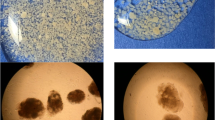Abstract
H2-producing bacteria were isolated from anaerobic granular sludge. Out of 72 colonies (36 grown under aerobic conditions and 36 under anaerobic conditions) arbitrarily chosen from the agar plate cultures of a suspended sludge, 34 colonies (15 under aerobic conditions and 19 under anaerobic conditions) produced H2 under anaerobic conditions. Based on various biochemical tests and microscopic observations, they were classified into 13 groups and tentatively identified as follows: From aerobic isolates,Aeromonas spp. (7 strains),Pseudomonas spp. (3 strains), andVibrio spp. (5 strains); from anaerobic isolates,Actinomyces spp. (11 strains),Clostridium spp. (7 strains), andPorphyromonas sp. When glucose was used as the carbon substrate, all isolates showed a similar cell density and a H2 production yield in the batch cultivations after 12h (2.24–2.74 OD at 600 nm and 1.02–1.22 mol H2/mol glucose, respectively). The major fermentation by-products were ethanol and acetate for the aerobic isolates, and ethanol, acetate and propionate for the anaerobic isolates. This study demonstrated that several H2 producers in an anaerobic granular sludge exist in large proportions and their performance in terms of H2 production is quite similar.
Similar content being viewed by others
References
Das, D. and T. N. Veziroğlu (2001) Hydrogen production by biological processes: a survey of literature.Int. J. Hydrogen Energy 26: 13–28.
Taguchi, F., J. D. Chang, S. Takiguchi, and M. Morimoto (1992) Efficient hydrogen production from starch by a bacterium isolated from termites.J. Ferment. Bioeng. 73: 244–245.
Kumazawa, S. and A. Mitsui (1981) Characterization and optimization of hydrogen photoproduction by a salt water blue-green alga,Oscillatoria sp. Miami BG7. I. Enhancement through limiting the supply of nitrogen nutrients.Int. J. Hydrogen Energy 6: 339–348.
Miyake, J. and S. Kawamura (1987) Efficiency of light energy conversion to hydrogen by the photosynthetic bacteriumRhodobacter sphaeroides.Int. J. Hydrogen Energy 12: 147–149.
Oh, Y.-K., E.-H. Seol, E. Y. Lee, and S. Park (2002) Fermentative hydrogen production by a new chemoheterotrophic bacteriumRhodopseudomonas palustris P4.Int. J. Hydrogen Energy 22: 1373–1379.
Yokoi, H., T. Ohkawara, J. Hirose, S. Hayashi, and Y. Takasaki (1995) Characteristics of hydrogen production by AciduricEnterobacter aerogenes Strain HO-39.J. Ferment. Bioeng. 80: 571–574.
Kim, M.-S., K.-W. Moon, I.-G. Lee, T.-J. Lee, and C.-K. Sung (1999) Hydrogen gas production by fermentation from various sugars usingClostridium butyricum NCIB 9576.Kor. J. Appl. Microbiol. Biotechnol. 27: 62–69.
Kumar, N. and D. Das (2000) Enhancement of hydrogen production byEnterobacter cloacae IIT-BT 08.Process Biochem. 35: 589–593.
Kumar, G. R. and T. M. Vatsala (1989) Hydrogen production from glucose byCitrobacter freundii.Ind. J. Exp. Biol. 27: 824–825.
Ahn, Y., Y. J. Lee, H.-S. Kim, and S. Park (2000) Monitoring of specific methanogenic activity of granular sludge by confocal laser scanning microscopy during start-up of thermophilic upflow anaerobic sludge blanket reactor.Biotechnol. Lett. 22: 1591–1596.
Jung, G. Y., J. R. Kim, H. O. Jung, J.-Y. Park, and S. Park (1999) A new chemoheterotrophic bacterium catalyzing water-gas shift reaction.Biotechnol. Lett. 21: 869–873.
Robson, R. (2001) Biodiversity of hydrogenases. pp. 9–32. In: R. Cammack, M. Frey, and R. Robson (eds.).Hydrogen as a Fuel: Learning from Nature. Taylor & Francis, London, UK.
Stanier, R. Y., J. L. Ingraham, M. L. Wheelis, and P. R. Painter (1986)The Microbial World. 5th ed., pp. 440–451. Prentice-Hall, Englewood Cliffs, New Jersey, USA.
Brosseau, J. D. and J. E. Zajic (1982) Continuous microbial production of hydrogen gas.Int. J. Hydrogen Energy 7: 623–628.
Kataoka, N., A. Miy, and K. Kiriyama (1997) Studies on hydrogen production by continuous culture system of hydrogen-producing anaerobic bacteria.Wat. Sci. Tech. 36: 41–47.
Author information
Authors and Affiliations
Corresponding author
Rights and permissions
About this article
Cite this article
Oh, YK., Park, M.S., Seol, EH. et al. Isolation of hydrogen-producing bacteria from granular sludge of an upflow anaerobic sludge blanket reactor. Biotechnol. Bioprocess Eng. 8, 54–57 (2003). https://doi.org/10.1007/BF02932899
Received:
Accepted:
Issue Date:
DOI: https://doi.org/10.1007/BF02932899




